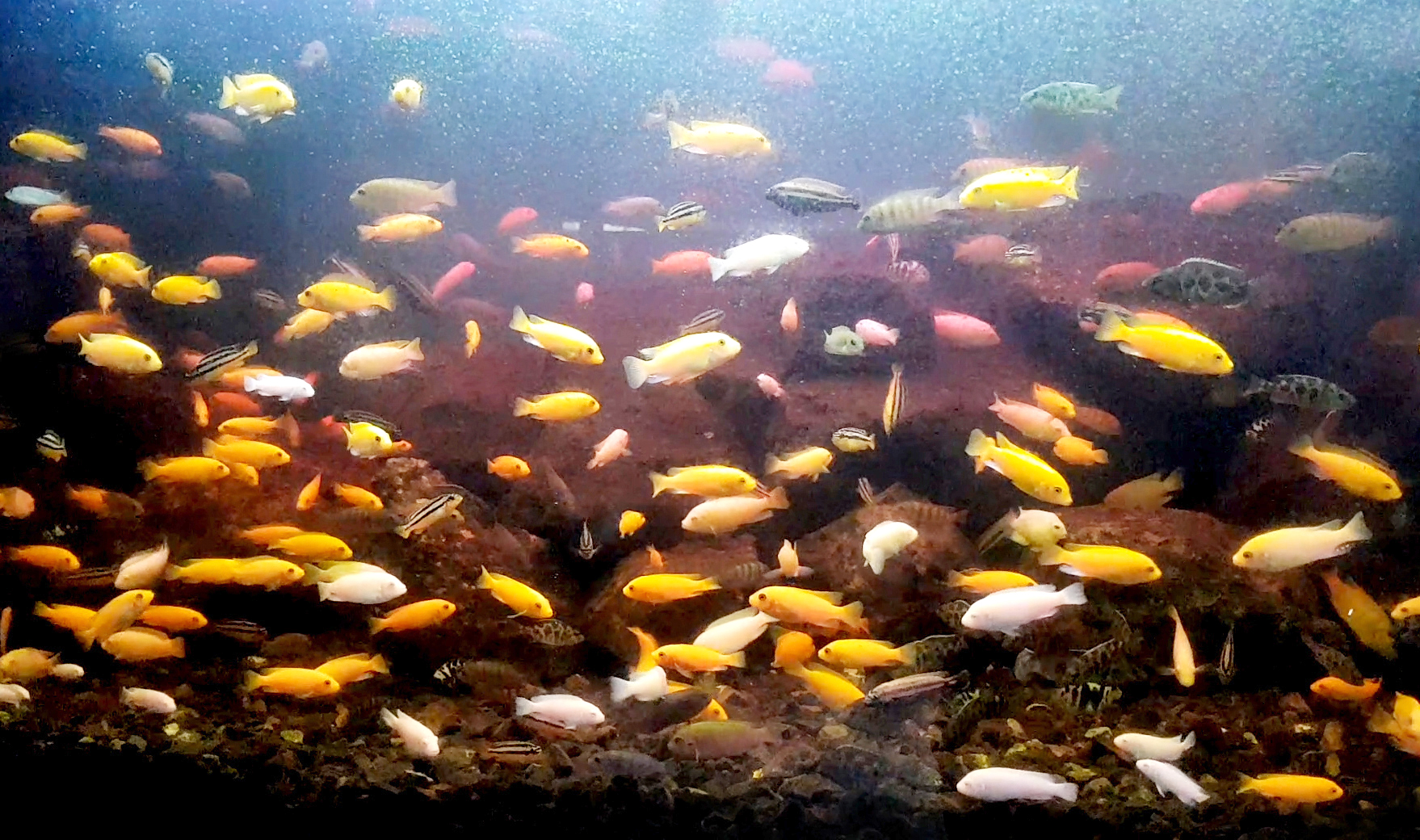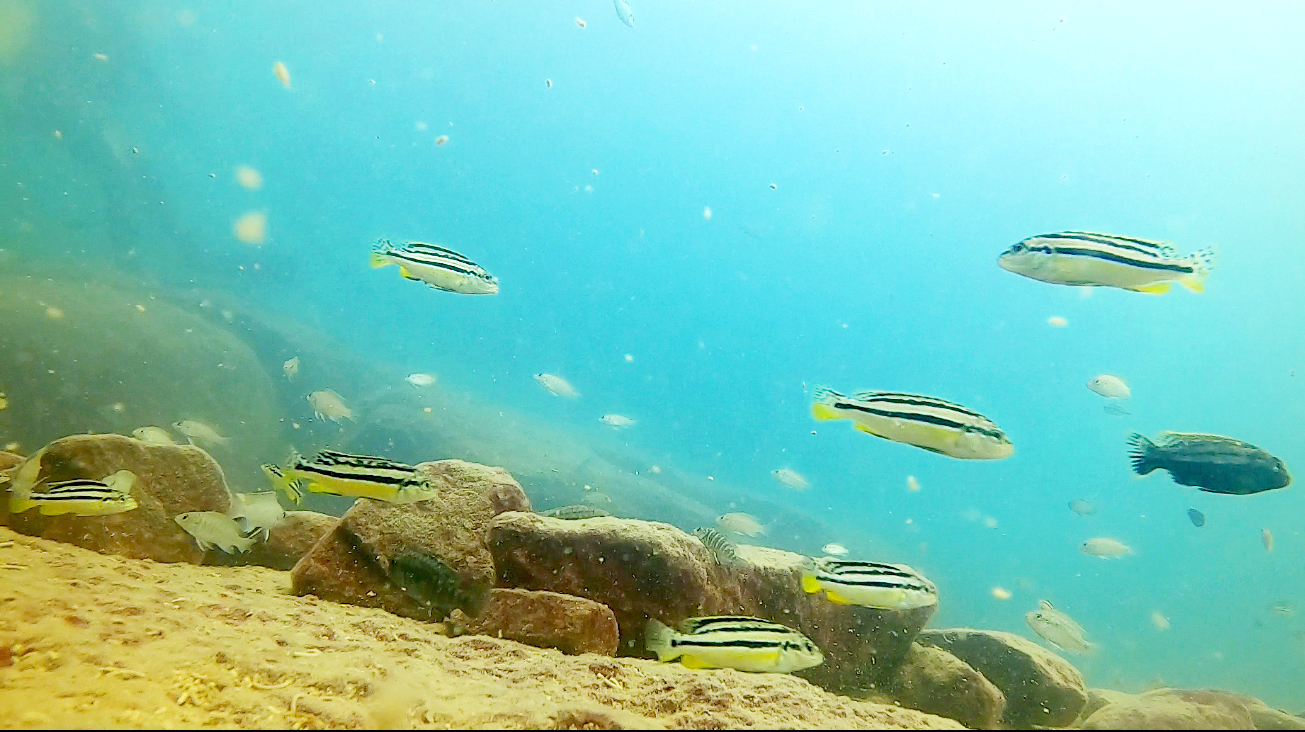Inside earth's most biologically diverse lake
Diving with the mutant fish of Lake Malawi in Africa
At A Glance
- I'm a Pinoy scuba diver and I travelled 10,000 kilometers to see these fish—some of which I've kept in my bubbling aquarium at home—in their home surf.
By Gregg Yan

I’m surrounded by mutants 30 feet down Lake Malawi in South Africa.
Like Spiderman, Wolverine, and Magneto, they’ve developed different abilities. Most evolved to graze on algae, which coats the enormous boulders around us. Others snuffle through the sand for worms and other wriggly tidbits. Some play dead and suddenly turn the tables on their hapless prey, while others rip and eat the scales off unsuspecting neighbors.
I glance at my dive guide, Felix Sinosi, while fiddling with my GoPro. I hope the tiny camera captures the swirling melee of color around us—neon blues and brilliant tangerines, glimmering
stripes, speckles, and spots. The fish patterns were so mesmerizing I almost forgot the warning Felix shared right before we backrolled into the lake’s blue waters: “A large Nile crocodile was spotted swimming here yesterday.”

fish industry
Meet the mbuna (em-buna), Lake Malawi’s mutant fish. They’re cichlids (sick-lids), members of a large family of freshwater fish whose members range from the striped angelfish of the Amazon basin to the tasty tilapia we farm and eat in the Philippines.
I’m a Pinoy scuba diver and I traveled 10,000 kilometers to see these fish—some of which I’ve kept in my bubbling aquarium at home—in their home surf.
There are 1,500 known cichlid species and over 600 of them inhabit just one lake, where fish mutate into new species every few thousand years. Scientists postulate that Lake Malawi’s 600 cichlid species evolved from a handful of fish that entered the lake three million years ago. These “ancestor fish” showed an unusually high level of genetic mutation and when they started colonizing Lake Malawi, their mutant genes spurred an intense period of speciation.

A 2018 paper by Malinsky et al. observes how “the formation of every new lake or island represents a fresh opportunity for colonization, proliferation, and the diversification of living forms. In some cases, the ecological opportunities presented by underutilized habitats facilitate what scientists call adaptive radiation—rapid and extensive diversification of the descendants of the colonizing lineages.”
The first to observe this was no less than Dr. Charles Darwin, who noticed that in the Galapagos Islands, tiny birds called finches morphed into different species to fill various ecological niches. So did the tiny cichlids evolve to colonize their giant new lake.
Lake Malawi slices through the South African nations of Malawi, Mozambique, and Tanzania. From afar, it looks like the ocean. It’s over 580 kilometers long and up to 700 meters deep.
In 1984, all of Lake Malawi was designated as a UNESCO World Heritage site for its incredible scientific value as a hotbed for fish evolution. Its fish are generally divided into two types: mbuna are rock-dwelling cichlids while utaka (ooh-taka) are open water cichlids, which either feed on drifting plankton or each other.
Interesting behavior plus vivid coloration have endeared these mutant fish to the world’s aquarists, who have been keeping and breeding them since the late 1950s. Melanochromis auratus, Pseudotropheus elongatus, Maylandia zebra, and many others are mainstays of the ornamental fish industry.
“The colors of mbuna are brilliant enough that they can be confused for coral reef fish,” notes Pinoy cichlid hobbyist Angel Ampil, who has been keeping fish for over 50 years. “Mbuna have distinct courtship and breeding behavior, plus they are relatively easy to breed in captivity.”

Malawi’s cichlids are probably the country’s best ambassadors. “The tropical aquarium trade has sent our cichlids all over the world,” explains Dr. Harold Sungani, deputy director of the Monkey
Bay Fisheries Research Center. “In addition to generating vital revenue, which can be channelled back into conservation and sound fisheries management, our cichlids continuously generate interest for tourists to visit Malawi and see the fish in the wild. Tourism, in turn, spurs peripheral trades like woodcarving and handicraft painting. The people of Malawi can see the importance of conserving a lake, which brings business to local communities.”
Back in the lake, visibility has gone bonkers. I’m following a family of golden Auratus cichlids when I hear the metallic tink, tink, tink of someone banging on his tank. Is the Nile crocodile back for a buffet? Has a curious hippo left the shallows to check us out? A large, dark shadow appears. I stop dead in the water.
In seconds it morphs—mutates if you will—into the form of Felix, signaling us to move on. Exhaling in relief, I follow him to see what scaly wonders lie over the next patch of rocks, recalling what I read before going to Africa.
“By learning how Malawi’s cichlids adapt and evolve under selective pressure, we can learn how these pressures affect humans in terms of health and disease,” remarked Federica di Palma, science director at The Genome Analysis Centre in the United Kingdom and co-author of a 2014
Harvard and MIT study on adaptive radiation.
With Covid-19 mutating every few months and losses amounting to trillions of dollars and millions of souls, it might just pay dividends for us to keep studying the mutant fish of Lake
Malawi.